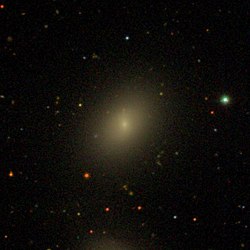| NGC 4306 | |
|---|---|
 SDSS image of NGC 4306. | |
| Observation data (J2000 epoch) | |
| Constellation | Virgo |
| Right ascension | 12h 22m 04.1s[1] |
| Declination | 12° 47′ 15″[1] |
| Redshift | 0.006608[1] |
| Heliocentric radial velocity | 1981 km/s[1] |
| Distance | 103 Mly (31.6 Mpc)[1] |
| Apparent magnitude (V) | 13.8[1] |
| Characteristics | |
| Type | SB0^0(s)[1] |
| Size | ~23,000 ly (7 kpc) (estimated)[1] |
| Apparent size (V) | 1.50 x 1.02[1] |
| Other designations | |
| UGC 07433, VCC 0523, PGC 040032, MCG +02-32-014[1] | |
NGC 4306 is a dwarf[2][3][4] barred lenticular galaxy located about 100 million light-years away[5] in the constellation Virgo. The galaxy was discovered by astronomer Heinrich d'Arrest on April 16, 1865.[6] Although considered to be a member of the Virgo Cluster,[4][7] its high radial velocity and similar distance as NGC 4305 suggest that NGC 4306 is a background galaxy.[8] NGC 4306 is a companion of NGC 4305[8] and appears to be interacting with it.[9][10]
References
[edit]- ^ a b c d e f g h i j "NASA/IPAC Extragalactic Database". Results for NGC 4306. Retrieved 2019-08-11.
- ^ Vazdekis, A.; Peletier, R. F.; Gorgas, J.; Cenarro, A. J.; Cardiel, N.; Balcells, M.; Aragon-Salamanca, A.; Whiley, I. M.; Toloba, E. (2007-12-12). "The relation between stellar populations, structure and environment for dwarf elliptical galaxies from the MAGPOP-ITP". Monthly Notices of the Royal Astronomical Society. 385 (3): 1374–1392. arXiv:0712.2017v1. doi:10.1111/j.1365-2966.2008.12846.x.
- ^ Rys, Agnieszka; Falcon-Barroso, Jesus; van de Ven, Glenn (2013-02-01). "Virgo cluster and field dwarf ellipticals in 3D - I. On the variety of stellar kinematic and line-strength properties". Monthly Notices of the Royal Astronomical Society. 428 (4): 2980–2994. arXiv:1210.3591. Bibcode:2013MNRAS.428.2980R. doi:10.1093/mnras/sts245. ISSN 0035-8711.
- ^ a b Davidge, T. J. (2018-10-31). "The Stellar Contents of Intermediate Mass Disk Galaxies in the Virgo Cluster. I. GMOS Spectra". The Astronomical Journal. 156 (5): 233. arXiv:1811.00041. Bibcode:2018AJ....156..233D. doi:10.3847/1538-3881/aae5fa. S2CID 119391307.
- ^ "Your NED Search Results". ned.ipac.caltech.edu. Retrieved 2019-08-12.
- ^ "New General Catalog Objects: NGC 4300 - 4349". cseligman.com. Retrieved 2019-08-02.
- ^ Binggeli, B.; Sandage, A.; Tammann, G. A. (1985-09-01). "Studies of the Virgo Cluster. II - A catalog of 2096 galaxies in the Virgo Cluster area". The Astronomical Journal. 90: 1681–1759. Bibcode:1985AJ.....90.1681B. doi:10.1086/113874. ISSN 0004-6256.
- ^ a b Sanchis, T.; Mamon, G. A.; Salvador-Sol´e, E.; Solanes, J. M. (2004-05-01). "The origin of H I-deficiency in galaxies on the outskirts of the Virgo cluster. II. Companions and uncertainties in distances and deficiencies". Astronomy and Astrophysics. 418 (2): 393–411. arXiv:astro-ph/0401367. Bibcode:2004A&A...418..393S. doi:10.1051/0004-6361:20034158. ISSN 0004-6361.
- ^ van den Bergh, Sidney; Pierce, Michael J.; Tully, R. Brent (1990-08-01). "Classification of galaxies on CCD frames". The Astrophysical Journal. 359: 4–14. Bibcode:1990ApJ...359....4V. doi:10.1086/169027. ISSN 0004-637X.
- ^ Malin, D. (1994). "Interacting Galaxies in the Virgo Cluster". Astronomy from Wide-Field Imaging. Vol. 161. pp. 567–576. Bibcode:1994IAUS..161..567M. doi:10.1007/978-94-011-1146-1_119. ISBN 978-0-7923-2879-7. S2CID 118943109.
External links
[edit]- NGC 4306 on WikiSky: DSS2, SDSS, GALEX, IRAS, Hydrogen α, X-Ray, Astrophoto, Sky Map, Articles and images
Well, that’s interesting to know that Psilotum nudum are known as whisk ferns. Psilotum nudum is the commoner species of the two. While the P. flaccidum is a rare species and is found in the tropical islands. Both the species are usually epiphytic in habit and grow upon tree ferns. These species may also be terrestrial and grow in humus or in the crevices of the rocks.
View the detailed Guide of Psilotum nudum: Detailed Study Of Psilotum Nudum (Whisk Fern), Classification, Anatomy, Reproduction